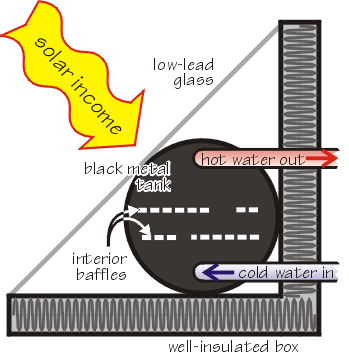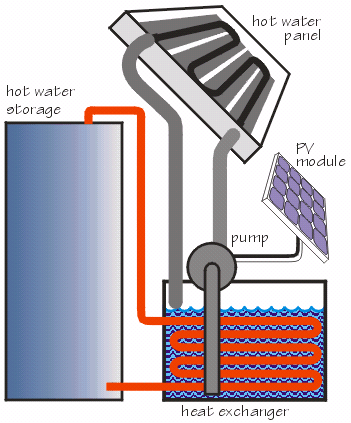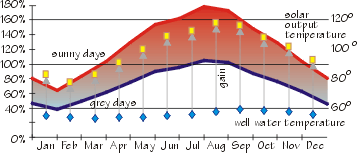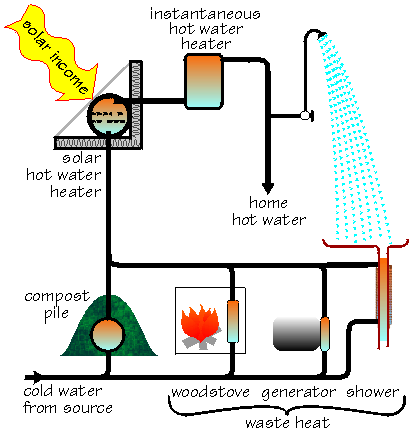
 |
The New Independent Home
by Michael Potts

from chapter 2 :
An American Fetish:
Hoarding Hot Water |
Installing a solar hot water system is probably the best resource- and money-saving action you can take. Choose one that is appropriate for your climate, and it will pay for itself in five years or less. But our modern-day hot water behavior is quite strange, and bears close examination.
Let me ask some personal questions. Are you a hot water hoarder? Do you have, somewhere in your abode, a tank full of hot water patiently awaiting your call? Most Americans do; most everyone in the rest of the world does not. It's one of our strangest cultural quirks. How long does it take from the time you turn on the hot water tap until water at its hottest comes out? One energy theorist pointed out that having a closetful of hot water is like leaving the car running in case you want to take a ride.
There are several remedies for this cultural aberration of ours. The simplest and most surprising, I find after years of teaching this subject, is to change our habits. Here's another personal question: When you go to the sink or bathroom lavatory and turn on the tap for a quick rinse, which tap do you turn? Most of us turn on the hot, and cheerfully wash our hands in the cold water that comes out. A stubborn few of us wait for the hot water; I have a bit more to say about them in a moment. Friends, the water from the cold tap is the same temperature. Discipline yourselves to turn that one instead. You do not suppose, I am sure, that the water heater, knowing your intentions, simply neglects to heat the water that will be orphaned in the walls or under the slab. Generally, by the time you have finished rinsing your hands, the hot water will have reached the tap, and when you turn it off, all its costly heat radiates into the indoor space so you or another member of your family can be treated to another cold rinse later in the day. Not even perfect insulation will fix this problem; self-discipline and energy awareness are the only remedies. I urge you to observe your behavior, and accept this small exercise: Get your cold water from the cold faucet!
In the most extreme (one might even be tempted to say obsessive) manifestation of energy abuse, many luxury homes employ a supremely wasteful practice called "circulating hot water," in which the house's entire hot water system, albeit usually well insulated, is connected to a pump which keeps hot water instantly available at any hot tap. Only the most stubborn, impatient, and I might say, greediest of American energy hogs would insist on hot water "in waiting." If you have circulating hot water, please turn off the pump -- the system will still work fine, and your water heating bill will cut itself by three quarters.
Another simple remedy is to make sure that your water heater is set to a reasonable temperature. Because we have agreed to give up the sporadic hot rinse, our heater should be set to deliver a large amount of perfectly tempered water; for most of us, that would be at or below 120°F. Water heaters are commonly delivered set to 140°F or hotter, so, since each degree Fahrenheit costs about a dollar a month, you can save quite a bit by adjusting the temperature so hot water out of the tap never scalds. If you have not already done this, please do it right now: Patiently adjust your hot water thermostat so that at its hottest, tap water is as hot as you ever want it, but no hotter. One hundred twenty degrees Fahrenheit is a good maximum. One hundred thirty degrees Fahrenheit, only ten degrees hotter (and hot enough to scald) costs up to 25% more.
|
|
A "breadbox" or batch solar water heater consists of a black tank in a well-insulated box. Cold water enters the tank near its lowest point and is removed from near the top. Baffles keep the incoming cold water from diluting water already heated by the sun. At night, the insulated box keeps the tank from losing its heat. The tank holds a "batch" of water, usually between 40 and 80 gallons. Because batch hot water heaters are passive and plumbed directly into the house system, they require no pumps or controls. Because they hold a large volume of water and typically a "pillow" of air, freezing is seldom a problem except in hard freezes experienced in the far northern tier of states.
|
 |
 |
Because the hot water panel in this system only holds fluid when the sun shines on the PV module and the pump runs, this is a reasonably freeze-proof system. Heat is collected in the panel, and raises the temperature of the heat exchanger, where it is transferred to incoming cold water. This is not a passive system, but it is PV-direct, meaning it operates only when the sun shines, which coincides with the time the panel will heat the transfer fluid. In cold climates, the transfer fluid often contains glycol-based antifreeze.
|
The next remedy, as already pointed out, is to install solar water heating. By using solar energy to heat water, we replace a highly significant energy load with a free source, and we are put in touch in a very important way with the day-to-day state of our planet. If we rely wholly on the sun for our hot water, before every shower we will devote just an instant's thought to our home's recent sun and water history. Has it been sunny? If so, there will be an abundance of hot water, but if not, it would be wiser to conserve. Has there been much hot water use since the last sunny period? If so, we would be wise to use sparingly or defer our water use, but if this is impossible, we must at least exercise our normal, water-conscious discipline. Independent families do not quarrel about this; they seem to take care of each other. An occasional tepid shower helps refine our estimating skills.
The solar industry has been severely criticized because of poorly installed water-heating equipment hustled into service during the OPEC oil crisis in order to take advantage of tax credits then being offered by a frightened government. The technology is much more mature now, as designers have learned many lessons about the need to plan for repairs necessitated by the corrosive qualities of hot water and the devastating effects of freezing. Opportunistic developers and other get-rich-quickers who flocked to the government trough have left town, and solar water-heater installers still in business are likely to be professional and competent, although you should still check references. |
|
In Caspar, the fraction of hot water energy provided by the sun shining on our pair of batch hot water heaters varies with the seasons, from 100% in August to 40% in February. These heaters paid for themselves in four years.
|

|
Most solar hot water systems are assisted by conventional water heaters. As the graph shows, my well water runs within a degree or two of 55°F, but I like my hot water at about 115°F, which means I must somehow get about 60°F of heat gain. The solar fraction, in winter, may be as low as 25%, because my solar collector supplies 70°F water even in a storm, and provides an average 15°F gain during our coldest month, February. On a typical Caspar summer day, the heating coils never see an electron, because the sun provides our total requirement of domestic hot water. I know this because I like to measure results, and have added three thermometers to my system; now I can watch the water temperature rise on a sunny day, monitor hot water availability, and gloat over my energy savings.
Although such systems still hoard hot water, in sunny times their electricity consumption is reduced to nothing. Some systems, which have little capacity for storing hot water in the collectors themselves, circulate heated water by thermosiphon (or, more commonly, by means of a pump) to a heat exchanger or storage tank, which partially justifies the large tankful of hot water we Americans like to hoard. In more gentle climates, a "breadbox" water heater like ours in Caspar, assisted by a propane- or natural-gas-fired "on-demand" water heater fitted with a sensor that suits the flame to the temperature of the incoming solar-preheated water, provides unlimited hot water while consuming the minimum amount of fuel possible. This is the most energy-efficient remedy. In especially cold climates, elaborate heat-exchanger systems are necessary to transfer and retain heat while avoiding freezing, but even so these will pay back their costs within seven years or less.
By putting a timer on the fossil-fueled backup we can avoid electrically heating water that will not be used until a little later in the day after the sun could do the job. For example, morning showerers cause the hot water they use to be replaced by cold water, which, being heavier, stays on the bottom of the water heater; the thermostat senses its presence and starts expensively heating it even though we may not need more hot water until evening, by which time the sun would have heated it for free. Most conventional water heaters recover in an hour or less, so allowing an hour's lead time is adequate. My system turns itself on once a day, late in the afternoon at the end of the solar day so that, if there has been sun, the water heater's thermostat allows it to use just enough energy to bring it up to my preferred temperature. Morning ablutions are more expensive because the solar-heated supply is at its lowest ebb then, and grid energy will almost always be needed for hot water, so it is reasonable to consider moving the habitual shower to the evening.
Even without the help of the sun, adjusting the water heater's performance to suit our particular life, so that it heats water no hotter than the temperature at which we will use it, and only during times we habitually require it, can save as much as a third of our present water heating bill.
The final option, if we are unable for technical, aesthetic, or historic reasons to install solar hot water, is to disconnect the energy-guzzling hot water storage-tank heater and install local hot water sources like the ones used everywhere else in the world where hot water is served. These devices, called demand or instantaneous water heaters, heat water only when it flows through them. By placing an instantaneous water heater close to the point of use, within a few feet of the sink or shower, there minimal water will be wasted while waiting for the hot stuff. Even if the new heater is installed at a distance from the kitchen sink, shower, and bathroom sink, for instance in the closet or basement where the old hoarder used to be and where plumbing already exists, hot-water energy expenses will decrease because keeping a standby quantity of hot water is costly.

| The cost of hot water can be reduced if the incoming water is preheated. By using the sun, the heat from a compost pile, and waste heat from used hot water, a woodstove, or a generator, it may be possible to eliminate the need for a hot water heater entirely. |
|


|